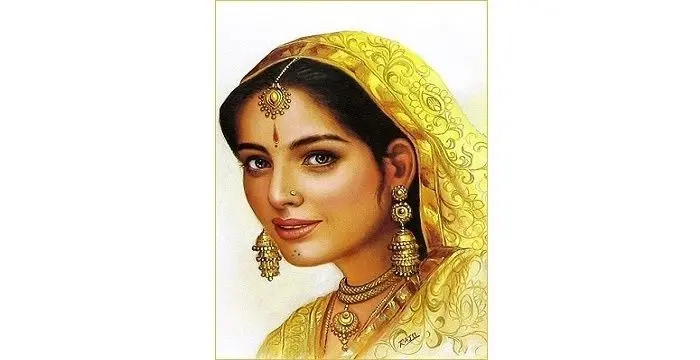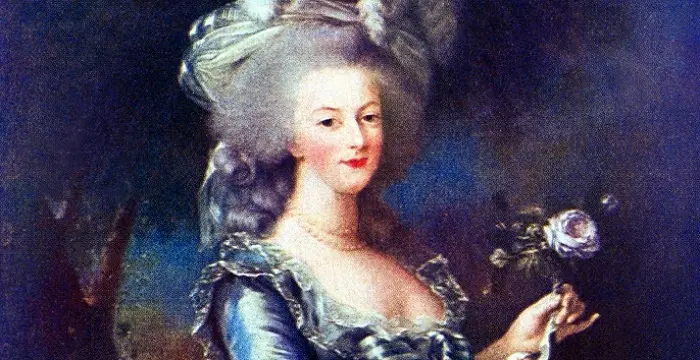
Rani Padmini - Queens, Birthday and Childhood
Rani Padmini's Personal Details
Rani Padmini or Padmavati was a legendary 13th-14th century Indian queen, who has inspired numerous tales of love and honor
| Information | Detail |
|---|---|
| Birthday | 1303 |
| Nationality | Indian |
| Famous | Historical Personalities, Empresses & Queens, Empresses, Queen of Chittor, Queens |
| Spouses | Ratnasimha |
| Known as | Padmavati |
| Gender | Female |
| Father | Gandharvsena |
| Mother | Champavati |
| Famous as | Queen of Chittor |
Rani Padmini's photo
Who is Rani Padmini?
Rani Padmini or Padmavati was a legendary 13th-14th century Indian queen, who has inspired numerous tales of love and honor since the first reference to her story was made by Indian poet Malik Muhammad Jayasi in his Awadhi language epic poem ‘Padmavat’ in the 16th century. The original fantasy tale depicts how Ratan Sen, the ruler of Chittor, married Padmavati following an epic quest, and how their union was challenged when Alauddin Khalji, the Sultan of Delhi, also fascinated by the tales of her beauty, invaded Chittor. Ratan Sen was killed in a combat by another admirer of Padmini, Devpal, the king of Kumbhalner; but before Khalji could breach the fort’s defenses, Padmini and the rest of the Rajput women committed jauhar (self-immolation) to protect their honor. While the historical authenticity of the legend has not been proved, many later poets and writers have contributed considerably in spreading the tale. The legend has been adapted into many movies, including the silent film ‘Kamonar Agun’, the Tamil film ‘Chittoor Rani Padmini’, the Hindi film ‘Maharani Padmini’ and the upcoming movie ‘Padmavati’.
// Famous Queens
Jetsun Pema
Jetsun Pema is the Queen consort of Bhutan. Check out this biography to know about her childhood, family life, achievements and fun facts about her life.
Princess Alice of Battenberg
Princess Andrew of Greece and Denmark, also known as Princess Victoria Alice Elizabeth Julia Marie of Battenberg, was the mother of Prince Philip, Duke of Edinburgh and mother-in-law of Queen Elizabeth II. This biography profiles her childhood, famil
Marie Antoinette
Marie Antoinette was the Queen of France and Navarre from 1774 to 1792. who played a major role in provoking the French Revolution. This biography of Marie Antoinette provides detailed information about her childhood and life
The Legend of Padmini
The earliest literary work to mention Rani Padmini by name is ‘Padmavat’, an epic poem written by Indian poet Malik Muhammad Jayasi in 1540 CE. According to this version of the story, Padmavati was the daughter of Gandharv Sen, the king of the Singhal kingdom (Sri Lanka).
She owned a talking parrot named Hiraman, but her father, who disliked her obsession with the bird, had ordered it to be killed. While the bird was able to fly away and save its life, it later fell into the hands of a bird catcher who sold it to a Brahmin.
Once the Brahmin brought the bird to Chittor, impressed by its ability to talk, the local king Ratan Sen purchased it from him. The parrot incessantly praised Padmavati’s heavenly beauty, which enamored the king who decided to embark on a quest to marry the princess.
The bird guided Ratan Sen and his 16,000 followers to Singhal, which they reached after crossing the seven seas. The king began ‘Tapasya’ in a temple which Padmavati visited after being informed by the parrot, but she left the temple without visiting him and regretted her decision once back in the palace.
Ratan Sen, who was about to immolate himself after learning that he missed the chance to meet the princess, was stopped by deities Shiva and Parvati who advised him to attack the royal fortress. He and his followers, still dressed as ascetics, were defeated and imprisoned, but as the king was about to be executed, his loyal bard revealed that he was the king of Chittor.
Gandharv Sen agreed to marry Padmavati to Ratan Sen and also arranged 16,000 ‘padmini’ (most desirable) women for his companions. As he began the return journey, the Ocean god created a devastating storm to punish him for his arrogance in winning over the most beautiful woman in the world.
Only Ratan Sen and Padmavati survived the storm, but were separated, during which time the daughter of the Ocean god, Lacchmi, appeared before the king disguised as Padmavati to test his love for her. After he passed the test, the Ocean god and his daughter united them and rewarded them with gifts.
As they finally reached Chittor, Ratan Sen, who was already married to Nagmati, witnessed a rivalry between his two wives. Soon after, one of his courtiers, Raghav Chetan, who was banished for fraud, reached the court of the Sultan of Delhi, Alauddin Khalji, and described Padmavati’s exceptional beauty.
Determined to obtain Padmavati, Khalji laid siege on Chittor, but when Ratan Sen offered him tribute to save his wife, he captured him by deceit after feigning a peace treaty. At Padmavati’s behest, Ratan Sen's loyal feudatories Gora and Badal reached Delhi dressed as Padmavati and her companions to free him, and while Gora was killed in a fight, Badal escorted Ratan Sen back to Chittor.
While Ratan Sen was imprisoned, a neighboring Rajput king, Devpal had made advances to Padmavati. When Ratan Sen returned to Chittor, he decided to punish Devpal for his misdemeanor. This resulted in a single combat duel between Ratan Sen and Devpal during which they killed each other.
In the meantime, Alauddin Khalji invaded Chittor again, following which Nagmati and Padmavati committed self-immolation (sati) on Ratan Sen's funeral pyre, with the other women of the fort committing mass self-immolation (jauhar) to save their honor.
Other Versions
The popularity of Malik Muhammad Jayasi’s account of Padmavati has sprouted many alternative versions of the story since the late sixteenth century. Among these versions, Hemratan's ‘Gora Badal Padmini Chaupai’ (c.1589 CE) is unique in that it was the first account of the story that claimed to be based on a “true tale”.
Many Rajput rulers of Rajasthan subsequently sponsored various retellings of the legend in the 16th to 18th century. These versions shifted focus from Jayasi's theme of courting and marriage to the pride of defending the Rajput honor while under attack from Muslim ruler Alauddin Khalji.
At least 12 Persian and Urdu translations or adaptations of Jayasi's ‘Padmavat’ have been recorded between 16th to 19th centuries. Many more versions have been written in the recent times, most of which follow the love poetry tradition of the original poet.
The British writer James Tod’s ‘Annals and Antiquities of Rajasthan’ (1829) states that Padmini, the daughter of Hamir Sank of Ceylon, was married to Bhim Singh, the uncle of Lachhman Singh, the ruler of Chittor. According to this account, which has since been branded as unreliable, Gora and Badal were Rani Padmini’s relatives from Ceylon, and Khalji had demanded to see her through a mirror.
Tod’s version inspired many adaptations in regional languages, especially in Bengali, which generally followed the Rajput narrative of the Hindu queen Padmavati immolating herself to protect her honor against a Muslim invader. Among these were Yagneshwar Bandyopadhyay's ‘Mewar’ (1884), Kshirode Prasad Vidyavinode's play ‘Padmini’ (1906) and Abanindranath Tagore's ‘Rajkahini’ (1909).
Historical Authenticity
Despite the fact that Alauddin Khalji's siege of Chittor (1303 CE) is a historical event, the legend of Rani Padmini itself has little historical authenticity. Amir Khusrau, who accompanied Khalji during the campaign, did not mention Padmini or Padmavati at all in is ‘Khaza'in ul-Futuh’.
In one of his later works, ‘Diwal Rani Khizr Khan’ in c.1315 CE, Khusrau again mentioned the siege of Chittor, as well as the romance between Alauddin and the princess of Gujarat, but not Padmini. However, some later scholars have attempted to interpret Khusrau’s references to Solomon, a hudhud bird, and Bilkis from the Islamic mythology as a subtle allusion to the Padmini story.
Based on the fact that other early accounts also omit any reference to Padmini, and that Khalji had many political reasons for the campaign, many historians maintain that the two events probably were not connected. While James Tod’s version of the story initially associated the legend with the historical siege, ‘Rajkahini’ by Abanindranath Tagore popularized Padmini as a historical figure among schoolchildren.
Trivia
After rumors spread that Sanjay Leela Bhansali’s 2017 film ‘Padmavati’ contains love scenes between Alauddin and Rani Padmini, he was accused of distorting history. A group of supporters of the extremist Rajput organization Shri Rajput Karni Sena also vandalized the film set and physically abused Bhansali.
// Famous Empresses
Jetsun Pema
Jetsun Pema is the Queen consort of Bhutan. Check out this biography to know about her childhood, family life, achievements and fun facts about her life.
Princess Alice of Battenberg
Princess Andrew of Greece and Denmark, also known as Princess Victoria Alice Elizabeth Julia Marie of Battenberg, was the mother of Prince Philip, Duke of Edinburgh and mother-in-law of Queen Elizabeth II. This biography profiles her childhood, famil
Marie Antoinette
Marie Antoinette was the Queen of France and Navarre from 1774 to 1792. who played a major role in provoking the French Revolution. This biography of Marie Antoinette provides detailed information about her childhood and life
Rani Padmini biography timelines
- // 1303Despite the fact that Alauddin Khalji's siege of Chittor (1303 CE) is a historical event, the legend of Rani Padmini itself has little historical authenticity. Amir Khusrau, who accompanied Khalji during the campaign, did not mention Padmini or Padmavati at all in is ‘Khaza'in ul-Futuh’.
- // 1315In one of his later works, ‘Diwal Rani Khizr Khan’ in c.1315 CE, Khusrau again mentioned the siege of Chittor, as well as the romance between Alauddin and the princess of Gujarat, but not Padmini. However, some later scholars have attempted to interpret Khusrau’s references to Solomon, a hudhud bird, and Bilkis from the Islamic mythology as a subtle allusion to the Padmini story.
- // 1540The earliest literary work to mention Rani Padmini by name is ‘Padmavat’, an epic poem written by Indian poet Malik Muhammad Jayasi in 1540 CE. According to this version of the story, Padmavati was the daughter of Gandharv Sen, the king of the Singhal kingdom (Sri Lanka).
- // 1589The popularity of Malik Muhammad Jayasi’s account of Padmavati has sprouted many alternative versions of the story since the late sixteenth century. Among these versions, Hemratan's ‘Gora Badal Padmini Chaupai’ (c.1589 CE) is unique in that it was the first account of the story that claimed to be based on a “true tale”.
- // 1829The British writer James Tod’s ‘Annals and Antiquities of Rajasthan’ (1829) states that Padmini, the daughter of Hamir Sank of Ceylon, was married to Bhim Singh, the uncle of Lachhman Singh, the ruler of Chittor. According to this account, which has since been branded as unreliable, Gora and Badal were Rani Padmini’s relatives from Ceylon, and Khalji had demanded to see her through a mirror.
- // 2017After rumors spread that Sanjay Leela Bhansali’s 2017 film ‘Padmavati’ contains love scenes between Alauddin and Rani Padmini, he was accused of distorting history. A group of supporters of the extremist Rajput organization Shri Rajput Karni Sena also vandalized the film set and physically abused Bhansali.
// Famous Historical Personalities
Sundiata Keita
Sundiata Keita was the founder of the Mali Empire in West Africa. This biography profiles his childhood, early life, struggles, founding of empire, rule, administration, achievements and also gives some fun facts.
Ashoka
Ashoka was the third emperor of the Mauryan Dynasty and ruled almost the entire Indian subcontinent. This biography profiles his childhood, life, reign, achievements and timeline
Jetsun Pema
Jetsun Pema is the Queen consort of Bhutan. Check out this biography to know about her childhood, family life, achievements and fun facts about her life.
Murad IV
Murad IV was one of the mighty Sultans in the history of the Ottoman Empire. This biography profiles his childhood, family, accession, rule, administration and timeline.
Xerxes I
Xerxes I (Xerxes the Great) was the fourth and the most famous king of the Archaemenid dynasty of Persia. This biography profiles his childhood, family, personal life, life history, achievements, campaigns, administration, death and other facts.
Sargon of Akkad
Sargon of Akkad, also called ‘Sargon the Great’, ‘Sarru-Kan’ and ‘Shar-Gani-Sharri’, was the founder and first king of the Akkadian Empire. This biography profiles his childhood, life, rule, administration, timeline, and gives some fun facts.
Rani Padmini's FAQ
What is Rani Padmini nationalities?
Rani Padmini's nationalities is Indian
Who is Rani Padmini spouses?
Rani Padmini's spouses is Ratnasimha
Who is Rani Padmini's father?
Rani Padmini's father is Gandharvsena
Who is Rani Padmini's mother?
Rani Padmini's mother is Champavati
How famous is Rani Padmini?
Rani Padmini is famouse as Queen of Chittor








